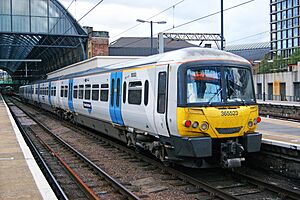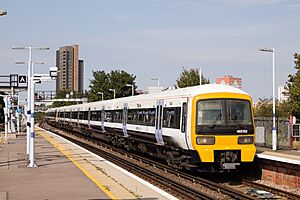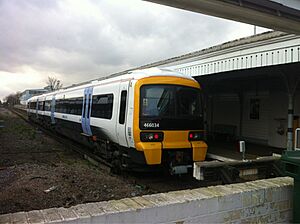Networker (train) facts for kids
Quick facts for kids Networker |
|
|---|---|
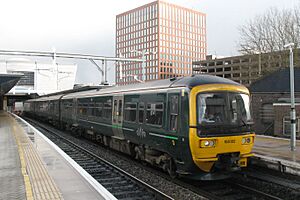
|
|
| In service | 1989–present |
| Manufacturer |
|
| Number built | 344 sets |
| Number scrapped | 40 sets |
| Operator(s) |
|
| Specifications | |
| Maximum speed | 75–100 mph (121–161 km/h) |
| Track gauge | 1,435 mm (4 ft 8 1⁄2 in) standard gauge |
The Networker is a type of passenger train used on the British railway system. These trains are called "multiple-units" because they can run by themselves without a separate engine. They were built in the late 1980s and early 1990s by companies like British Rail Engineering Limited (BREL) and Metro Cammell. The trains got their name because they were made for the Network SouthEast (NSE) part of British Rail.
Contents
History of Networker Trains
When Network SouthEast started in 1986, they announced the "Networker" trains. These new trains were a big part of NSE's plan to make their railway system more modern. They were designed to replace older trains, especially those with "slam-door" carriages that needed a separate engine to pull them.
Networker trains were special because they used aluminium for their bodies. This made them lighter. The electric versions also had modern AC motors and air conditioning. The idea was for Networker trains to be used on all future NSE routes, even new ones like the Channel Tunnel Rail Link. NSE planned to order about 300 carriages every year.
The Networker was meant to be a very large family of trains. However, because of an economic slowdown in the early 1990s and the privatisation of British Rail starting in 1994, fewer trains were built. About 340 trains were made, which was much less than first planned.
Types of Networker Trains
Diesel Trains
Class 165

The Class 165 is a diesel train with 2 or 3 carriages. These trains were built for journeys outside of big cities. Thirty-nine of these trains (Class 165/0) were made for Chiltern Network SouthEast between 1990 and 1991. Another thirty-seven (Class 165/1) were built for the Thames area in 1992. Today, Chiltern Railways uses the Class 165/0 trains. The Class 165/1 trains are now used by Great Western Railway.
Class 166
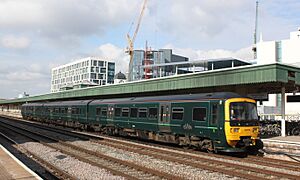
The Class 166 is a faster version of the Class 165. It has air conditioning and was built for main railway lines. Twenty-one 3-carriage trains were made for the Thames and North Downs areas of Network SouthEast in 1992 and 1993.
Electric Trains
Classes 316 and 457
These numbers were given to a single 4-carriage electric train. It was made from older Class 210 carriages and used for testing new ideas. It was called Class 457 for tests using 750 V direct current (DC) power on Southern Region lines. Then it was called Class 316 for tests using 25 kV alternating current (AC) power from overhead lines.
Class 365
The Class 365 was an electric train that could use two different types of power. These trains were ordered in 1993. Forty-one 4-carriage trains were built from 1994 to 1995. Some could pick up power from a third rail, used for services between London and Kent. Others used power from overhead lines for services from London King's Cross to Peterborough and King's Lynn. The Class 365 trains were taken out of service by Great Northern on May 15, 2021, and have since been scrapped.
Class 465
The Class 465 is a 4-carriage electric train. It gets its power from a 750 V DC third rail. Different companies built slightly different versions. After British Rail was privatized, these trains were used by several operators. They are currently operated by SE Trains.
Class 466
The Class 466 is a 2-carriage electric train. It also gets power from a 750 V DC third rail. These trains are often linked with 4-carriage Class 465s to make longer trains (6 or 10 carriages). Forty-three units were built between 1993 and 1994. Some Class 466 units began to be scrapped in early 2025.
Trains That Were Planned But Not Built
Some Networker trains were designed but never actually built.
- Class 171 was planned as a long-distance diesel train. However, other trains became available, so the Class 171 was not needed.
- Classes 331 and 332 were electric trains planned for specific routes, like the London, Tilbury and Southend line and Heathrow Express. Different trains were built for these routes instead.
- Classes 341 and 342 were also electric trains that were planned. The Class 341 was for a project called Crossrail, which was cancelled at the time. The Class 342 was for services using the Channel Tunnel Rail Link. These projects didn't happen as planned, so the trains were not built.
- Classes 371, 381, and 471 were long-distance electric trains that were proposed. They were meant to be very flexible, able to use different power systems. However, after British Rail was privatized in 1994, no more of these trains were ordered.
Comparing Networker Trains
| Class | Image | Current operator | Introduced | Qty. | Cars | Car length |
|---|---|---|---|---|---|---|
| Diesel multiple units | ||||||
| 165 | 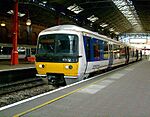 |
Chiltern Railways | 1990–1992 | 39 | 2 or 3 | 22 m (72 ft 2 in) |
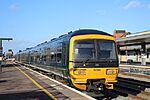 |
Great Western Railway | 1992 | 36 | 2 or 3 | 22 m (72 ft 2 in) | |
| 166 |  |
1992–1993 | 21 | 3 | 22 m (72 ft 2 in) | |
| Dual-voltage | ||||||
| 316 and 457 | 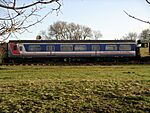 |
(Scrapped, preserved or inserted into Class 455 units) | 1989–1990 | 1 | 4 | |
| 365 |  |
(Scrapped) | 1994–1995 | 41 | 4 | 20 m (65 ft 7 in) |
| DC electric only | ||||||
| 465 |  |
Southeastern | 1991–1994 | 147 | 4 | 20 m (65 ft 7 in) |
| 466 |  |
1993–1994 | 43 | 2 | 20 m (65 ft 7 in) | |


